PMG Identifies New Overprint Variety
Posted on 10/16/2018
An interesting Uruguay 1896 50 centesimos note was recently submitted to PMG for grading. The note was verified and authenticated by PMG as being a “SALTO” branch location overprint variety that was previously unlisted in the Standard Catalog of World Paper Money (SCWPM). This has now been assigned Pick #2d (overprint on Pick #2b).
 |
|
| 1896 Uruguay 50 centesimos (Pick #2d) - SALTO overprint, front PMG graded Very Fine 25 Click image to enlarge. |
|
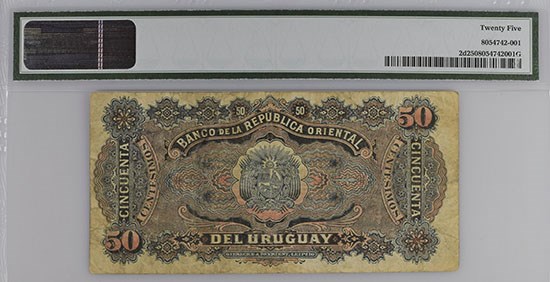 |
|
| 1896 Uruguay 50 centesimos (Pick #2d) - SALTO overprint, back PMG graded Very Fine 25 Click image to enlarge. |
|
Uruguay branch location overprints refer to identification stamps that were placed on notes by inland local agencies of the country. It is relatively common to find the earlier Banco Nacional 1862 series with branch location overprints—a total of twenty different branch names are listed as possible overprint varieties for Uruguay Pick #A87-A98.
However, for the 1896 Banco de la Republica Oriental del Uruguay issued series (Pick #2-8), branch location overprints are quite scarce and rarely seen. To date, overprints have only been confirmed for the 50 centesimos and 1 peso denominations, while none are known for the 5, 10, 50, 100 and 500 pesos denominations.
Overprint examples of the 1896 50 centesimos (Pick #2c and 2d) have been known to sell for thousands of dollars, while the relatively more common regular-issued examples with no overprint (Pick #2a and 2b) can be purchased for about $100 in F-VF condition.
A review of the historical events at the time can help provide a better understanding as to why these branch location overprint notes are so scarce today.
In August 1896, the government-run Banco de la Republica Oriental was newly created, and in the following month on September 30th, the government signed a contract for banknotes to be printed in Germany by the company Giesecke and Devrient of Leipzig.
The denominations contracted for were 10, 20 and 50 centesimos and 1, 2, 5, 10, 100 and 500 pesos denominations. These were to be engraved over multicolor backgrounds, with printing done on high-quality hemp thread paper with a watermark.
Unfortunately, in May 1897, when the authorities of the bank inspected the first shipment of 10 centesimos banknotes in Hamburg, they disliked the look of the notes. The Board of Directors of the Bank immediately submitted some samples to technical experts for an opinion. All the experts agreed that the note design was too simplistic and could easily be counterfeited.
To avoid a lengthy and costly battle, it was ultimately decided that the printing house would provide new high-quality engraved 50 centesimos and 1 peso banknotes in substitution for the previously printed lower quality 10 and 20 centesimos and one peso notes; the low-quality notes would be destroyed.
Given the problems associated with the printing of the order, it was not until January 1898 that the first shipment of 1896-dated 50 centesimos notes started to circulate in Uruguay. Claudio Rotondaro, author of Emisiones del Banco de la Republica Oriental del Uruguay, 1896-1967, makes the comment that these 1896-dated overprint notes had a short-lived “mayfly life.”
While there is little information known about these overprint issues (such as the different branch location names printed on the notes and how many were overprinted in total), Rotondaro does mention that on December 31, 1898, a resolution by the Board of Directors stated that branch location overprints would no longer be valid on the “minor issuance” 50 centesimos and 1 peso notes. The resolution allowed that branch location overprints could continue to be used on higher denomination notes (as can be seen from the rare 1899-dated 10 pesos note (Pick #8A) with known overprint varieties).
The 1896-dated 50 centesimos notes with branch location overprints—produced during a single year in 1898—represent a small fraction of the total population compared to the non-overprinted notes. Since they were no longer valid in 1899, it seems probable that most overprinted notes were promptly removed and destroyed—contributing to their rarity today.
The SALTO overprint, Pick #2d, was unknown to the collecting community until the discovery of this example submitted to PMG. For the 1896 50 centesimos, SCWPM now lists two overprint varieties: ROSARIO (Pick #2c) and SALTO (Pick #2d). In Uruguay, Rotondaro has identified the existence of three additional overprint varieties: ARTIGAS, MALDONADO, and ROCHA. So to date, a total of five overprint varieties are known for the 50 centesimos denomination.
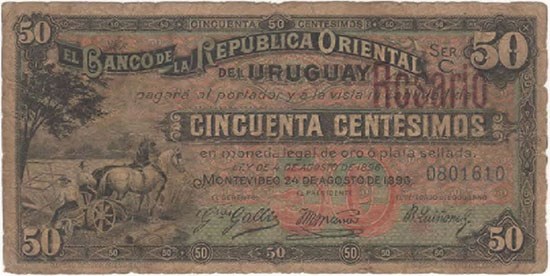 |
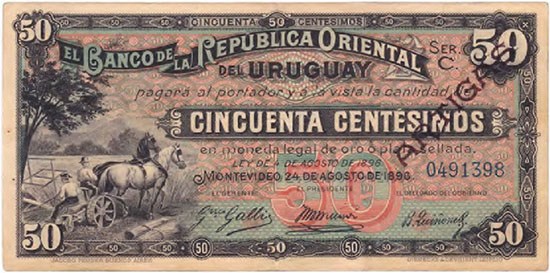 |
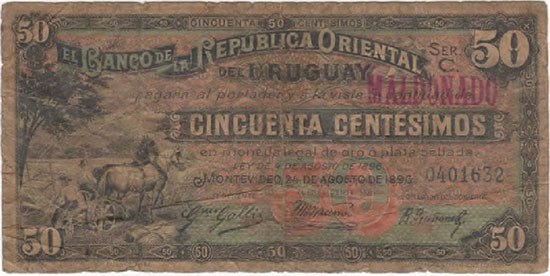 |
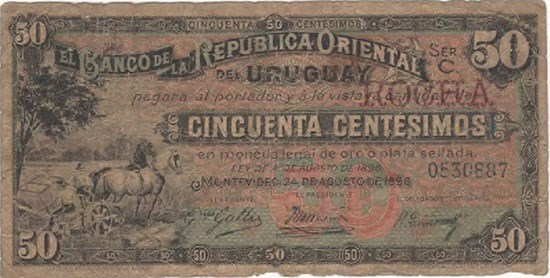 |
| Clockwise from top left: ROSARIO, ARTIGAS, ROCHA, and MALDONADO branch location overprint varieties of Uruguay 1896 50 centesimos. Images courtesy of Claudio Rotondaro. |
|
With twenty different branch names as possible overprint varieties, and just five identified to date, it would seem logical that additional overprint varieties may be out there waiting to be discovered.
Sources
- Rotondaro, Claudio. Emisiones del Banco de la República Oriental del Uruguay / 1896 – 1967, 1a Edición - Octubre 2016
Stay Informed
Want news like this delivered to your inbox once a month? Subscribe to the free PMG eNewsletter today!